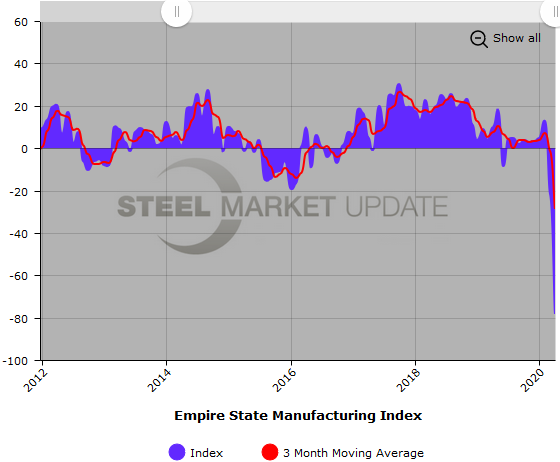Economy

Empire State Manufacturing Plummets in April to Record Low
Written by Sandy Williams
April 16, 2020
The Empire State Manufacturing Survey plunged to its lowest level ever, falling 57 points to a reading of -78.2, in April. “By way of comparison, the lowest level this indicator had reached prior to April was -34.3 during the Great Recession,” said the New York Federal Reserve.
New York City has been the epicenter for the U.S. COVID-19 outbreak, impacting manufacturing across the state as shelter-in-place edicts were imposed. New orders, shipments and employment levels declined at record rates. Inventories fell and delivery times lengthened.
Selling prices declined for the first time since 2016, tumbling to an index reading of -8.4. The prices paid index dropped 19 points to 5.8, indicating that price growth of raw materials slowed during April.
The six-month outlook showed that firms are expecting only a slight improvement in business conditions, including moderate increases in new orders and shipments. New investments are on the back burner as spending indexes for capital expenditures and new technology both tumbled to -11.0.
The New York report followed a government report that showed retail sales fell 8.7 percent in March, the biggest decline in the survey’s history.
“Manufacturing has never been in worse shape. Severely depressed demand, supply disruptions, and extremely high uncertainty will keep manufacturing on an extremely weak trajectory in the near term,” said Oren Klachkin, economist at Oxford Economics, as quoted by MarketWatch.
Below is a graph showing the history of the Empire State Manufacturing Index. You will need to view the graph on our website to use its interactive features; you can do so by clicking here. If you need assistance logging in to or navigating the website, please contact us at info@SteelMarketUpdate.com.


Sandy Williams
Read more from Sandy WilliamsLatest in Economy

Steel, manufacturing, and union groups divided on S232 tariffs
Domestic steel trade associations, manufacturing groups, and the United Steelworkers (USW) union had mixed reactions to the implementation of new Section 232 tariffs without exclusions on Wednesday. Trade groups representing steel mills broadly supported President Trump’s actions, while the USW and some groups representing manufacturers were more critical. AISI Kevin Dempsey, president and CEO of […]

CRU: Will US tariff policy be transactional or transformational?
The Trump 1.0 tariffs appeared to have little positive effect on the US manufacturing, partly because they hurt export competitiveness.

Beige Book finds mixed demand trends, tariff concerns
Manufacturing activity exhibited slight to modest increases across a majority of districts. However, manufacturers expressed concerns over the potential impact of looming trade policy changes between late January and February.

Construction spending drops marginally in January
Construction spending edged down slightly in January, slipping for the first time in four months. The US Census Bureau estimated spending at a seasonally adjusted annual rate of $2,196 billion in January, down 0.2% from December’s downward revised rate. The January figure is 3.3% higher than a year ago. January’s result, despite the slight erosion, […]

ISM: Manufacturing expansion slowed in February
The Manufacturing PMI registered 50.3% in February. That’s 0.6 percentage points lower compared to the 50.9% recorded in January.
